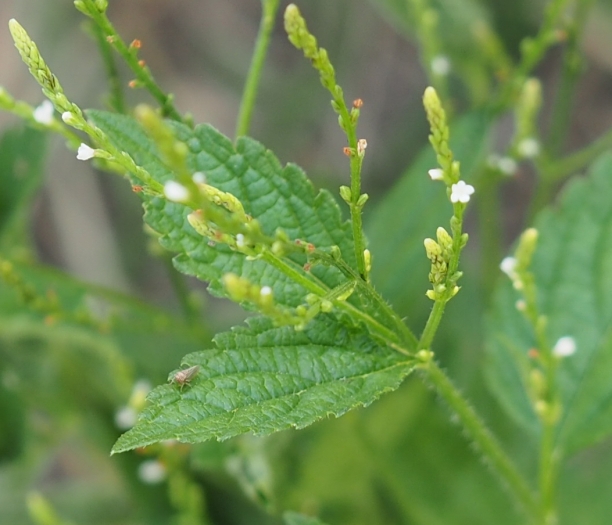White Vervain
(Verbena urticifolia)
White Vervain (Verbena urticifolia)
/
/

mefisher
Public Domain
Image By:
mefisher
Recorded By:
Copyright:
Public Domain
Copyright Notice:
Photo by: mefisher | License Type: Public Domain | License URL: http://creativecommons.org/publicdomain/zero/1.0/ | Rights Holder: mefisher | Publisher: iNaturalist | Date Created: 2019-09-27T11:16:50-07:00 |



















































Estimated Native Range
Summary
Verbena urticifolia, commonly known as White Vervain, is a deciduous perennial herb native to open woodlands, forest edges, and fields across the Eastern United States and into Canada. It typically grows to a height of 3 to 6 feet (0.9 to 1.8 meters) with a spread of 2 to 3 feet (0.6 to 0.9 meters). White Vervain has a vertical growth habit with thin, rigid, green stems and opposite, simple leaves that are coarsely toothed. The small, tubular flowers are borne in slender, elongated spikes and bloom from mid-summer to early fall. The flowers are white, a rarity in the normally bluish-flowered Verbena genus, and are not particularly showy. The fruit is a dark-colored capsule containing numerous brown, thin seeds, and the plant is covered in stiff bristles, except for the flowers and fruit.
White Vervain is valued for its wildlife benefits, particularly for attracting butterflies and other pollinators. It is used in naturalized plantings, wildflower gardens, and as a background plant in borders due to its height. It tolerates a range of soil conditions but prefers moist, well-drained soils and can thrive in both full sun and part shade. While it is not aggressive, it can self-seed and spread in optimal conditions. Gardeners should be aware that the stiff bristles can cause skin irritation upon handling.CC BY-SA 4.0
White Vervain is valued for its wildlife benefits, particularly for attracting butterflies and other pollinators. It is used in naturalized plantings, wildflower gardens, and as a background plant in borders due to its height. It tolerates a range of soil conditions but prefers moist, well-drained soils and can thrive in both full sun and part shade. While it is not aggressive, it can self-seed and spread in optimal conditions. Gardeners should be aware that the stiff bristles can cause skin irritation upon handling.CC BY-SA 4.0
Plant Description
- Plant Type: Herb
- Height: 2-3 feet
- Width: 0.667-1 feet
- Growth Rate: Moderate
- Flower Color: White
- Flowering Season: Summer
- Leaf Retention: Deciduous
Growth Requirements
- Sun: Part Shade
- Water: Medium, High
- Drainage: Slow, Medium
Common Uses
Bee Garden, Bird Garden, Butterfly Garden, Deer Resistant, Drought Tolerant, Hummingbird Garden, Low Maintenance, Rabbit Resistant
Natural Habitat
Native to open woodlands, forest edges, and fields
Other Names
Common Names: Burvine, Nettle-Leaf Vervain, Nettle-Leaved Vervain, Verveine Blanche, Verveine À Feuille D’Ortie, Verveine À Feuilles D’Ortie, Amerikansk Järnört, Bur-Vine
Scientific Names: , Verbena urticifolia, Verbena urticifolia var. urticifolia, Verbena urticifolia var. leiocarpa, Verbena diffusa, Verbena urticifolia f. incarnata, Verbena curtisiae, Verbena curtisii, Verbena incarnata, Verbena urticifolia f. simplex
GBIF Accepted Name: Verbena urticifolia L.